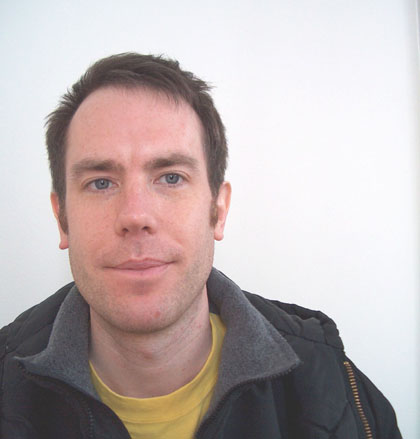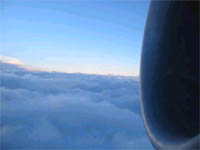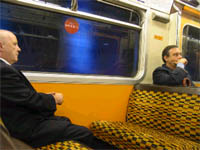|
[23. april 2003]

Interview with David Crawford
Last week we presented David Crawford's net
art project Stop Motion Studies, which is a series of extremely
short studies predominantly from the subways. This
week Thomas Petersen interviews David Crawford about Stop
Motion Studies.
read
our presentation of Stop Motion Studies
Stop Motion Studies: www.lightofspeed.com
Email David Crawford at: crawford@lightofspeed.com
You will need Flash
6 to view the project.
Tell me about your interest in subways -- what makes them particularly
interesting from thematic, social and photographic points of view?
Thematically, the SMS work is consistent with the net art I've been
doing online since 1996, with major themes being identity and speed.
Socially, the subway is the proverbial melting pot. Subway riders
might say they would prefer to drive if this was economically viable,
but the gains stemming from this unpredictable social contact --
the insights and the empathy one develops -- are invaluable. Cinematically,
subways are an irresistible subject, with their very form (windows/frames
on tracks) resembling the machinery of a projector and the experience
of being a passenger not unlike seeing a motion picture.
You get pretty close to the people you are photographing --
do your subjects ever freak out because you get too close? Do you
ever feel that you are invading the private spaces of your subjects?
Body language speaks volumes and if someone's gesture says "back
off," I do. One thing I've resolved myself to is that no matter
how interesting the subject or how much I may covet an image, ultimately
this is not an exercise in upsetting people. For me, the work raises
timely questions about our right to privacy in spaces increasingly
under heavy surveillance. Ultimately however, my aim is to celebrate
these spaces and the people in them.
One might argue that you contribute to this surveillance…
A friend recently pointed out to me that self-surveillance is the
logical outgrowth of centralised surveillance. One question I've
had lately is: how do people experience automated -- often invisible
-- surveillance, differently than active, perceptible surveillance
by an individual?
Why is it so interesting to watch intimate recordings of dull
everyday life?
Some movies end with the world being saved from oblivion. Others
simply end with two people coming to terms with each other. As everything
is relative, both can be equally cathartic. At the outset of the
project I spent a great deal of energy looking for the extraordinary.
I've since realised that I get better results when I "find
without seeking," so to speak.
You have included sequences of clouds and views from aeroplanes.
To me these images are interesting juxtapositions to the images
of urban life. What are your own thoughts on symbolism?
The perpetual motion of both sky and subway mirror each other, but
with a strong contrast of texture and association. While shooting
in Paris I started thinking about Joshua Davis' Opel Cloud series
(URL below) and thought it might be interesting to try a bitmapped
spin on these vector animations. I proceeded to remove all the other
representational elements and ended up with the initial sequence
for SMS - Series 3.
 
Screendumps:
LON.01.Exterior.Clouds and LON.18.Men.Watch_b
Your use of the computer and the camera seems almost ascetic.
For example, you operate with several self-imposed restrictions
-- like not cropping or retouching the images. Is there any sort
of conceptual agenda behind this method?
At the heart of the SMS project is a strong impulse to escape the
hothouse of the computer and re-enter the world. It goes back to
the truism of there being "no freedom with limitation."
If I allowed myself to alter the images there would be no end to
it and I'd spend unnecessary time in front of the computer.
Does this logic of non-manipulation also apply to the selection
and editing of the sequences or do you, for example, construct the
humour of a sequence?
I've always loved editing, so this process -- rather than photo-manipulation
-- is where I've chosen to spend my time on the SMS project. For
any one sequence you see, you're looking at between 1% and 5% of
the raw footage generated for that sequence. In some cases, hundreds
and hundreds of frames are removed from a sequence that ends up
becoming only two or three frames long. It's a strategy of using
the creative potential of the computer as a tool for indexing and
sorting data.
The sequences seem to balance between simple motion video and
sequences of single still photographs. What interests you about
this particular border between two media types?
As they exist in an art context, both photography and video come
with liabilities in terms of distribution, presentation and collection.
The SMS work incorporates aspects of both mediums within a net art
context, while minimising some of these liabilities. There are always
trade-offs, but what really matters is that I've seen things in
these sequences -- like people breathing -- that I've never seen
in either photography or video.
I think your answer points to one of the key roles of art --
to sharpen our senses towards the details -- the noise -- we usually
filter out. Do you feel this is important -- and has the development
of the project affected your own personal sensory habits?
Our ability to isolate and perceive information is a survival skill.
For example, a large part of the brain is exclusively dedicated
to processing facial expressions -- perhaps this explains our tendency
to see things like the "man on the moon." In any case,
I would say that -- as a tool -- the project has changed the way
I see.
Why did you add a multi-screen presentation platform? What do
you think this contributes to the user's perception of the material?
SMS - Series 7 started as a series of informal discussions with
Christiane Paul about what kind of meta-structure would allow for
the most successful application of "database logic." In
the resulting interface, a 2x2 grid allows for immediate comparisons
between four different cities, with the unique characteristics of
each city being reinforced by its neighbours in the grid.
Will you develop the interface further - if so, what will be
the next development?
SMS - Series 8 may involve some new tactics, but I'm not expecting
to develop anything new in terms of interface.
Compared to a lot of other net art it seems like you don't deal
as explicitly with technological themes but more in explorations
of social situations and the photographic medium. Do you have any
comments on Stop Motion Studies' role as net art?
The network is a social situation and the subway is a network. There
is a strong technological theme -- perhaps even more so than in
many works of net art.
Do you have any favourite net art links you'd like to share?
I've enjoyed what I've seen of the Data Diaries:
http://www.turbulence.org/Works/arcangel
Also, the URL for the Opel Cloud series:
http://ps3.praystation.com/pound/v2
|